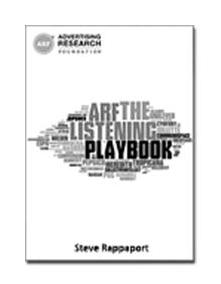The Listening Playbook: Q&A With the ARF's Steve Rappaport - Ed Keller - MediaBizBloggers

"Listening is hip," declares The ARF Listening Playbook. It "changes the game for brands and people." Recently I conducted a Q&A session with the book's author, Steve Rappaport, ARF Knowledge Solutions Director, who was also the lead author of the 2007 book, The Online Advertising Playbook. (Disclosure: I am on the ARF Board.)
Q: Why this book, why now?
A: Interest in listening has crossed an inflection point, from curiosity to recognition that listening can make significant contributions to brand marketing and advertising. ARF members and many in the industry want to learn more about listening and are asking four fundamental questions: what is listening, how is it used, how is it done, and where is it going? The ARF Listening Playbook organizes and synthesizes the research, cases, marketplace results and technologies to provide a foundation for this emerging practice. It's intended to be an essential reference and a business tool, helping readers understand how to use listening for new product development, sharpening messaging, repositioning, or detecting consumer shifts, or trying to figure out which listening solutions might fit the bill, or looking for cutting edge uses.
Q: You were the lead author of The Online Advertising Playbook, a book that explained online advertising, how it works and why it works. Are the issues you discuss here as transformative for brands as online advertising? Why or why not?
A: Listening's impacts are potentially more far reaching. Listening fundamentally influences how we, as marketing, media, and advertising professionals, understand, relate to, serve, and communicate with people. Whereas online advertising, rich as it may yet become, is the expression of insights, not their source.
Q: What is the "news you can use" – what will a brand marketer learn from reading The ARF Listening Playbook?
A: There are four "top stories." The first – a meaningful, operational discipline of listening. As with any new field, listening is defined in many ways – often, we learned, in ways that support a particular point of view. We set out to establish a non-partisan definition to benefit the industry. Secondly, we learned through analyzing over 35 case studies that listening helps brands accomplish the full spectrum of marketing objectives from discovering new customers, through innovation, maintaining sales momentum, and loyalty, for example. Cutting the cases a different way, we looked for the research applications listening is used for. There we found that listening supported those used for decades, but done differently – such as problem identification, segmentation, message development and testing, brand attribute discovery, customer profiling and, of course, insights. Thirdly, the book provides a guide to the myriad listening solutions available, by categorizing them into four buckets – search and monitoring, text analysis, listening platforms, and private communities. For each we list out and explain their key features, which readers are using to see which solutions map to their needs and also serve as criteria to jumpstart RFPs. Fourthly, listening data is inspiring new ways of budgeting, predicting outcomes like sales and market shares, qualifying audiences for media targeting, planning and buying, and influencing organizational relationships because listening information is increasingly used by marketing, media, PR, legal, R&D, and customer service. Lastly, listening is not a fad or flavor of the month.
Q: You say "listening changes the game for brands and people." How so?
A: In several ways. Most important is that it can more closely calibrate the brand-customer relationship than we've been able to in quite some time, because brands and people can more easily listen, hear, and respond to one another. Additionally, listening adds the important dimension of context, which markedly enriches our ability to understand, analyze, and draw insights from. Combined with data from other sources, such as surveys or shopper data, the combination of listening with structured data can lead to conclusions and action plans that benefit brands and consumers. Listening is not just for consumer insights and customer care, but that listening data is now being used to aid forecasting and being incorporated into various sorts of models. For that reason, listening is also changing the game because it is helping brands enrich and improve the data they base decisions on.
Q: You describe listening as an "emerging discipline." How far along the evolutionary cycle would you say it is?
A: That has to be answered two ways. From a foundational standpoint, many of the research approaches, like content analysis, have been in service since World War II, and the technologies like computational linguistics are decades old; there's a degree of maturity in them. From a corporate adoption perspective, it's still early in the adoption process. The good news is that the conversation around listening has shifted from experiments to figuring out how to make it a corporate practice.
Ed Keller, CEO of the Keller Fay Group, has been called "one of the most recognized names in word of mouth." The publication of Keller's book,The Influentials, has been called the "seminal moment in the development of word of mouth." Ed can be contacted at ekeller@kellerfay.com.
Read all Ed’s MediaBizBloggers commentaries at Ed Keller - MediaBizBloggers.
Follow our Twitter updates @MediaBizBlogger


